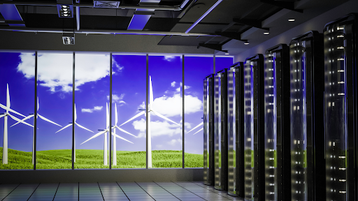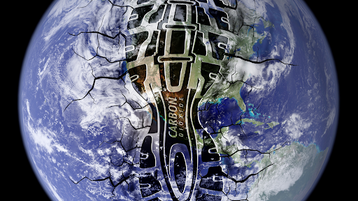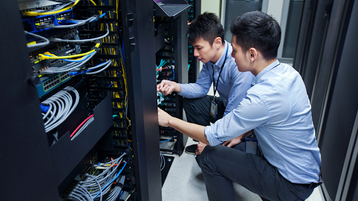In the digital age, data centers have become the backbone of the Internet, supporting everything from cloud storage to streaming services. However, their environmental impact is significant due to high energy consumption and carbon emissions. This article explores the importance of sustainability in data centers, highlighting green practices and technologies that can mitigate their environmental footprint.
Energy efficiency
Energy consumption in data centers is vast, driven by the need to power and cool numerous servers. Traditional data centers are often inefficient, with a significant portion of energy lost in the process. In contrast, modern data centers employ various strategies to enhance energy efficiency.
Virtualization is one such strategy, reducing the number of physical servers needed by running multiple virtual machines on a single server. This not only cuts down on hardware costs but also reduces energy consumption significantly. Furthermore, AI and machine learning are increasingly used to optimize energy use by predicting demand and adjusting power supply accordingly.
Advanced cooling systems are crucial for maintaining energy efficiency. Techniques like free cooling, which utilizes outside air, and liquid cooling, which transfers heat more efficiently than air, are becoming standard.
The effectiveness of these cooling methods can be measured using metrics such as the cooling capacity factor (CCF) and power usage effectiveness (PUE).
Key metrics for data center energy efficiency:
- To minimize PUE (the ratio of total facility energy to IT equipment energy)
- To optimize CCF (the ratio of cooling capacity to critical load)
- To maximize data center infrastructure efficiency (DCiE; the percentage of total energy used by IT equipment)
Integration of renewable energy
Renewable energy integration is a pivotal aspect of making data centers sustainable. Many data centers are now powered by solar, wind, and geothermal energy, reducing reliance on fossil fuels and minimizing carbon emissions. Companies like Google and Microsoft are leading the way with ambitious goals to run their data centers entirely on renewable energy.
Localized energy matching is an effective strategy for optimizing renewable energy use. This involves purchasing renewable energy based on its availability in specific locations, thus ensuring a steady and efficient energy supply. For instance, solar energy is more abundant in sunny regions, making it a viable option for data centers in such areas.
Despite the benefits, there are challenges in integrating renewable energy, such as the intermittent nature of sources like solar and wind. However, advancements in energy storage and grid management are gradually overcoming these obstacles.
Reducing carbon footprint and emissions
Data centers contribute significantly to global carbon emissions, making it essential to adopt measures that reduce their carbon footprint. Carbon usage effectiveness (CUE) is a metric used to assess a data center's carbon emissions relative to its energy consumption. By minimizing CUE, data centers can significantly lower their environmental impact.
Strategies for carbon reduction include using renewable energy, optimizing energy efficiency, and participating in carbon offset programs. Leading tech companies have set ambitious targets for carbon neutrality, inspiring others to follow suit.
For example, Microsoft aims to be carbon-negative by 2030, not only reducing its own emissions but also removing more carbon from the atmosphere than it emits.
Key metrics for carbon reduction in data centers:
- To minimize CUE (the ratio of CO2 emissions to IT energy)
- To maximize energy reuse effectiveness (ERE; the ratio of reused energy to total energy)
- To maximize green energy coefficient (GEC; the percentage of energy generated from renewable sources)
Advanced cooling technologies
Cooling is one of the largest energy expenses for data centers. Traditional air cooling systems are often inefficient, prompting the need for more advanced solutions. Free cooling, which leverages outside air, is a cost-effective method for data centers in cooler climates. Liquid cooling, on the other hand, uses water or other coolants to transfer heat away from servers more efficiently than air.
Another innovative approach is the reuse of waste heat. Some data centers are located near residential areas or industrial sites where excess heat can be used for heating buildings or processes, thereby improving overall energy efficiency.
The effectiveness of cooling solutions is measured by various metrics, including the CCF and PUE. These metrics help data center operators optimize their cooling systems, reducing energy use and costs.
Sustainable construction and retrofitting
Building and retrofitting data centers sustainably involves adhering to green building certifications like Leadership in Energy and Environmental Design (LEED) and Building Research Establishment Environmental Assessment Method (BREEAM). These certifications ensure that buildings meet high environmental performance standards.
Modular data center designs are becoming popular due to their efficiency and flexibility. These designs allow for scalable growth and can be built using sustainable materials, reducing the environmental impact of construction.
Retrofitting existing data centers to improve sustainability involves upgrading infrastructure to more energy-efficient systems and integrating renewable energy sources.
While this can be challenging and costly, the long-term benefits of energy savings and reduced emissions are substantial.
Waste management in data centers
Data centers generate significant electronic waste (e-waste) from outdated or broken hardware. Proper waste management practices are essential to minimize the environmental impact of this e-waste. Recycling programs and lifecycle management of IT equipment can help ensure that materials are reused or disposed of responsibly.
Zero waste initiatives aim to divert all waste from landfills through recycling, reusing, and reducing waste production. Implementing such programs requires collaboration between data center operators, suppliers, and customers.
Technological innovations for sustainability
Emerging technologies play a crucial role in enhancing data center sustainability. AI and machine learning can automate energy management, predicting demand and adjusting resources to optimize efficiency. These technologies also enable predictive maintenance, reducing downtime and extending the lifespan of equipment.
Blockchain technology offers energy tracking and management potential, ensuring transparency and efficiency in energy use. As blockchain applications become more widespread, they could provide valuable tools for managing data center energy consumption.
Technological innovations for data center sustainability:
- Using AI and machine learning for energy management and predictive maintenance to optimize efficiency
- Using Blockchain for energy tracking and transparency to enhance management
- Using advanced cooling systems for efficient heat transfer and waste heat reuse to reduce energy use
Metrics and benchmarks for sustainability
To ensure continuous improvement, data centers must track and benchmark their sustainability performance. Key metrics include PUE, DCiE, and GEC. Tools and software for tracking these metrics are essential for identifying areas for improvement and ensuring compliance with sustainability goals.
Key sustainability metrics for data centers:
- To minimize PUE
- To maximize DCiE
- To maximize GEC
Conclusion
Sustainability in data centers is no longer an option but a necessity. As the digital world continues to expand, data centers must adopt green practices to mitigate their environmental impact. By focusing on energy efficiency, integrating renewable energy, reducing carbon emissions, and implementing advanced technologies, data centers can become more sustainable.
The future of green data centers looks promising, with continuous innovations and increasing awareness driving progress. As more companies commit to sustainability, the industry can achieve significant environmental benefits while maintaining the essential services that support our digital lives.




